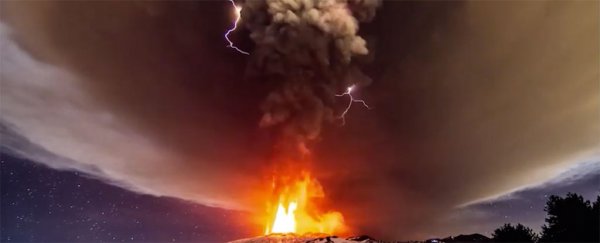Europe's tallest active volcano, Mount Etna, has erupted in spectacular fashion, filling the sky above Sicily with flame, lightning, and a gigantic ash cloud. Mount Etna has been mostly quiet for two years, but after intensifying volcanic activity in recent weeks, things came to a head with the dramatic eruption you can see in the video above.
The footage, shot by Sicilian photographer Marco Restivo, captures what it looked like when Mount Etna's Voragine crater let loose. According to Italy's National Institute of Public Geophysics and Volcanology (INGV), this was a short but very violent eruption, ranking among the most violent Etna has seen in the past two decades.
Occurring between 2:20am and 3:10am UTC, the eruption saw a sustained lava fountain reach heights of over 1 kilometre, although some jets of hot material made it as high as 3 km above the summit of the volcano. The large volcano boasts five craters in total and is estimated to have been active for some 2.5 million years.
Ash fell onto the nearby villages Linguaglossa, Francavilla di Sicilia, Milazzo, Messina, and Reggio Calabria, and resulted in the closure of at least one airport.
What's most remarkable about the footage of the eruption is how well it captures what's called a 'dirty thunderstorm', a weather phenomenon that results in the production of lighting in a volcanic plume.
The phenomenon was also witnessed when Chile's Cabulco volcano erupted for the first time in 43 years earlier this year, producing a breathtaking display of lightning and lava.
As ScienceAlert's Bec Crew explains, the phenomenon doesn't just result in amazing light shows that next to nobody gets to see in the flesh – it also generates a freakish natural byproduct: perfectly spherical glass balls:
It's thought that the glass fragments are caused when massive ash clouds are spewed forth from the mouth of a volcano, and as the individual ash particles make contact and rub against each other, they produce enough static electricity to convert into bursts of lightning.
This lightning could be the key to creating the spheres … because they heat the air within the ash clouds to temperatures of around 30,000 degrees Celsius (54,000 degrees Fahrenheit), within mere millionths of a second. This melts the glass particles into a molten liquid, and as these liquid droplets are plummeting through the air, they cool into little orb shapes.
Mount Etna's fireworks aren't the only volcanic show in town this week either. We've also seen Nicaragua's Momotombo volcano explode with fury – and it hadn't erupted in over a century.
